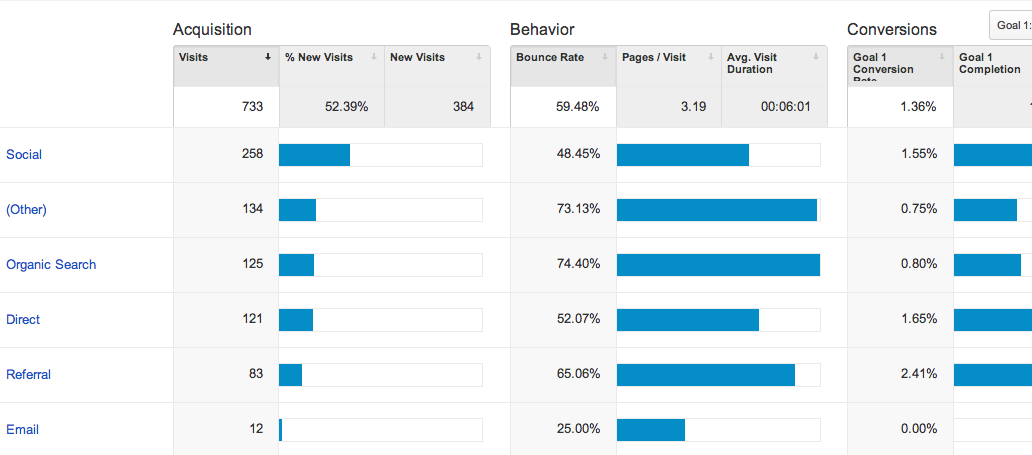What Data Is Google Analytics Goals Unable to Track: A Complete Guide
What Data Is Google Analytics Goals Unable to Track: A Complete Guide
Blog Article
Revealing the Blind Destinations: Comprehending What Google Analytics Goals Can not Determine
In the world of electronic analytics, Google Analytics stands as an effective tool for tracking and evaluating on the internet user interactions. In the middle of its durable capacities, there exist blind places that commonly avert measurement. what data is google analytics goals unable to track. Comprehending what Google Analytics goals can not gauge is critical for obtaining a thorough sight of individual behavior and engagement. As we dive right into the complexities of these unseen areas, we uncover an intricate internet of uncharted territories that hold beneficial understandings right into individual actions and inspirations, tough traditional wisdom and clarifying the constraints of our data-driven understanding.
Individual Actions on External Operatings Systems
Comprehending exactly how customers interact on outside systems is important for maximizing on-line approaches. Outside platforms, such as social networks networks, referral internet sites, and online discussion forums, play a significant function in driving traffic to a business's internet site. By examining customer behavior on these systems, businesses can get valuable understandings right into the effectiveness of their advertising initiatives and the preferences of their target audience.
One trick aspect of user habits on exterior platforms is the recommendation resource. By tracking where the customers are coming from, companies can determine which systems are driving the most traffic to their site. This details can aid companies assign their sources extra effectively, focusing on the platforms that produce the very best outcomes.

Offline Interactions and conversions
Analyzing individual behavior on outside systems provides beneficial understandings into online strategies; however, considering offline conversions and communications is equally important for a detailed understanding of a firm's general efficiency. Offline conversions, such as in-store acquisitions or phone questions, play a considerable duty in several organizations' success.

Acknowledgment Beyond Last Click
When diving right into the realm of electronic advertising and marketing analytics, it becomes necessary to look past the solitary touchpoint of the last click for a more thorough understanding of attribution. While Google Analytics offers useful understandings right into customer actions, relying exclusively on last-click attribution can be restricting - what data is google analytics goals unable to track. Attribution models that surpass the last click provide a much more nuanced view of the customer journey, thinking about all the touchpoints that result in a conversion
Attribution past the last click permits marketing professionals to appoint credit history to numerous communications along the conversion path, offering a more clear photo of the efficiency of various advertising and marketing networks. By exploring multi-touch attribution models such as direct, time degeneration, or position-based attribution, companies can better designate their marketing budgets and maximize their methods for optimal impact.
Understanding the impact of each touchpoint in the conversion process is vital for making notified choices and making the most of ROI. By accepting acknowledgment beyond the last click, services can get deeper insights into client actions and tailor their advertising efforts better.
Cross-Device and Cross-Browser Monitoring

In a similar way, cross-browser tracking complements cross-device monitoring by recording individual actions as they switch over between different internet internet browsers. Understanding how users interact with websites on various internet browsers can help marketing experts optimize their on the internet experiences to ensure consistency and capability throughout different platforms.
Qualitative Data and User Intent
Recognizing individual intent with qualitative data analysis is critical for developing targeted electronic advertising approaches that resonate with the needs and choices of the target market. Qualitative data offers understandings right into the 'why' behind individual activities, clarifying motivations, emotions, and choices that quantitative data alone can not record. By examining user comments, comments, and interactions, online marketers can uncover valuable information regarding user intent, enabling them to customize their messaging, web content, and offerings to better straighten with what their target market is looking for.
Qualitative information additionally assists in recognizing the context in which customers engage with a site or app. This contextual understanding makes it possible for marketing professionals to produce even more appropriate and customized experiences, inevitably driving greater interaction and conversion rates. By diving right into individual intent via qualitative information evaluation, businesses can get a much deeper understanding of their target market, causing a lot more reliable marketing strategies that meet individuals' assumptions and requirements.
Conclusion
In verdict, Google Analytics goals have restrictions in measuring individual behavior on outside platforms, offline conversions, attribution past last click, cross-device and cross-browser monitoring, and qualitative information connected to individual intent. what data is google analytics goals unable to track. It is essential for organizations to be knowledgeable about these blind areas in order to supplement their information analysis with various other tools and techniques to obtain a more detailed understanding of their target market and improve their general electronic advertising try here and marketing methods
By assessing customer behavior on these platforms, services can obtain valuable insights into the efficiency of their advertising and marketing initiatives and the preferences of their target audience.
Evaluating customer actions on external platforms offers important insights into on the internet methods; nonetheless, considering offline conversions and interactions is equally imperative for a comprehensive understanding of a company's overall performance.In digital advertising and marketing analytics, moving beyond last-click acknowledgment to explore cross-device and cross-browser monitoring is crucial for obtaining an all natural understanding of customer communications throughout different platforms and gadgets. By evaluating user feedback, comments, and communications, online marketers can uncover valuable details concerning customer intent, enabling them to tailor their messaging, content, and offerings to much better straighten with what their target market is seeking.
By delving into user intent via qualitative information evaluation, companies can acquire a much deeper understanding of their see here now target audience, leading to a lot more effective advertising and marketing methods that satisfy users' needs and assumptions.
Report this page